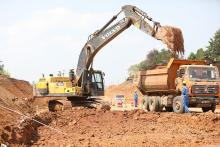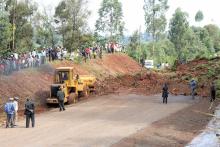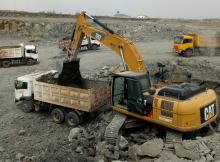
East Africa is a region being transformed by a lasting building boom. While Burundi, Djibouti, Eritrea, Ethiopia, Rwanda, Seychelles, Somalia, Tanzania and Uganda are, to a greater or slightly lesser extent, all benefiting from higher national government and foreign investment in energy, transport, and residential and commercial building infrastructure, no single nation appears to be investing more heavily than Kenya.
As reported recently in Aggregates Business International’s sister publication Global Report Construction Equipment 2018, Kenya’s real estate sector alone has been growing for the past three years, with its contribution to the country’s gross domestic product rising to 8.8% in 2016, up from 7.2% in 2015, according to Kenya’s National Bureau of Statistics.
Furthermore, the report, East Africa’s Building Boom, commissioned by the Big 5 Construct East Africa – International Building & Construction Show, and based on East Africa’s top ten construction projects, puts Kenya as the biggest national beneficiary of increased building sector activity. Among the region’s ten largest construction schemes is Kenya’s US$2.1 billion Tatu City project, which will accommodate 150,000 people on completion.
Regular readers of this magazine will have noted last issue’s quarry profile on how Sirikwa Quarry is among aggregates processing sites benefiting from the insatiable demand for building materials coming from new infrastructure linked to a US$2 billion special economic zone, launched in July 2017 in the Kenyan town of Eldoret. The economic zone is helping to create nearly 40,000 direct and indirect jobs.
There is also huge demand for building materials in and around Kenya’s capital city, Nairobi. However, the area is acting as the unofficial epicentre of a bitter East African regional debate about the use of black volcanic sand in construction projects.
In this edition of ABI, Shadrack Kavilu reports on how a proposed Kenya-wide ban on the use of the building material on safety and quality grounds, particularly when used in high-rise and high-end construction projects, will hit the country’s building industry, an industry that has been increasingly turning to cheaper alternatives to diminishing conventional river sand.
As Shadrack notes, black volcanic sand is a major source of employment and provides livelihoods for thousands of young men and women working in the mining and transport sector. Furthermore, the implementation of any ban on the use of the commodity in building works may not be easy to enforce. The East African construction and aggregates sector will certainly be keeping a close eye on how the black volcanic sand debate plays out.
This issue’s market report on the Korean aggregates sector was written against a backdrop of the historic meeting between Kim Jong-Un, North Korea’s leader, and Moon Jae-in, South Korea’s president, on 27 April. The meeting has been widely hailed a success in moving the two Koreas’ relationship towards a friendlier footing after a prolonged period of deep tensions and mistrust.
What hasn’t been in the global news spotlight, but will be of great interest to major and ambitious smaller international aggregates producers, is the healthy state of South Korea’s aggregates and construction sectors.
Asia’s fourth largest economy, South Korea has witnessed huge development of its commercial, residential and transport infrastructure, leading to greater and greater demand for raw construction materials and construction and quarrying equipment. The country produces more than 330 million tonnes/year of aggregates to service its infrastructure needs, an impressive sum which is generating a wealth of attractive commercial opportunities for indigenous building materials suppliers and the world’s quarrying and construction equipment OEMs.
Without doubt, East Africa and East Asia share much common ground when it comes to the vibrancy of their construction and quarrying sectors.










